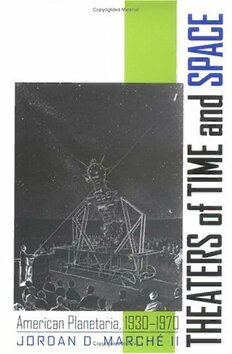
Theaters Of Time And Space: American Planetaria, 1930-1970 PDF
295 Pages·2005·1.641 MB·English
Most books are stored in the elastic cloud where traffic is expensive. For this reason, we have a limit on daily download.
Preview Theaters Of Time And Space: American Planetaria, 1930-1970
Description:
"March? carefully shows how local and national interests produced the first five major American planetarium theaters—in Chicago, Philadelphia, Los Angeles, New York, and Pittsburgh—as well as hundreds of smaller ones—in Pennsylvania schools and in other locations around the country. The millions of people who have found education or entertainment in a planetarium will find great background reading in Theaters of Time and Space!"—Dr. Marvin Bolt, director, history of astronomy department, Adler Planetarium & Astronomy Museum, Chicago"A timely and valuable contribution to our understanding of the evolution of public science in America. Theaters of Time and Space clarifies the importance of emotional engagement in the public’s enduring enthusiasm for astronomical discovery. Its natural audience is planetarium specialists, but it is also a cultural history that will engage the general reader."—Dr. E. C. Krupp, Griffith ObservatoryEvery year, millions of Americans visit planetariums and are captivated by their strikingly realistic portrayal of the night sky. Today, it is indeed difficult to imagine astronomy education without these magnificent celestial theaters. But projection planetariums, first developed in Germany, have been a part of American museum pedagogy only since the early twentieth century and were not widespread until the 1960s. In this unique social history, former planetarium director and historian of science Jordan D. March? II offers the first complete account of the community of individuals and institutions that, during the period between 1930 and 1970, made planetariums the popular teaching aids they are today. March? addresses issues such as the role of gender and social developments within the planetarium community, institutional patronage, and the popularization of science. He reveals how, at different times, various groups, including financial donors, amateur scientists, and government officials, viewed the planetarium as an instrument through which they could shape public understanding and perceptions of astronomy and space science. Offering an insightful, wide-ranging look into the origins of an institution that has fascinated millions, Theaters of Time and Space brings new perspectives to how one educational community changed the cultural complexion of science, helped shape public attitudes toward the U.S. space program, and even contributed to policy decisions regarding allocations for future space research.
See more
The list of books you might like
Most books are stored in the elastic cloud where traffic is expensive. For this reason, we have a limit on daily download.
